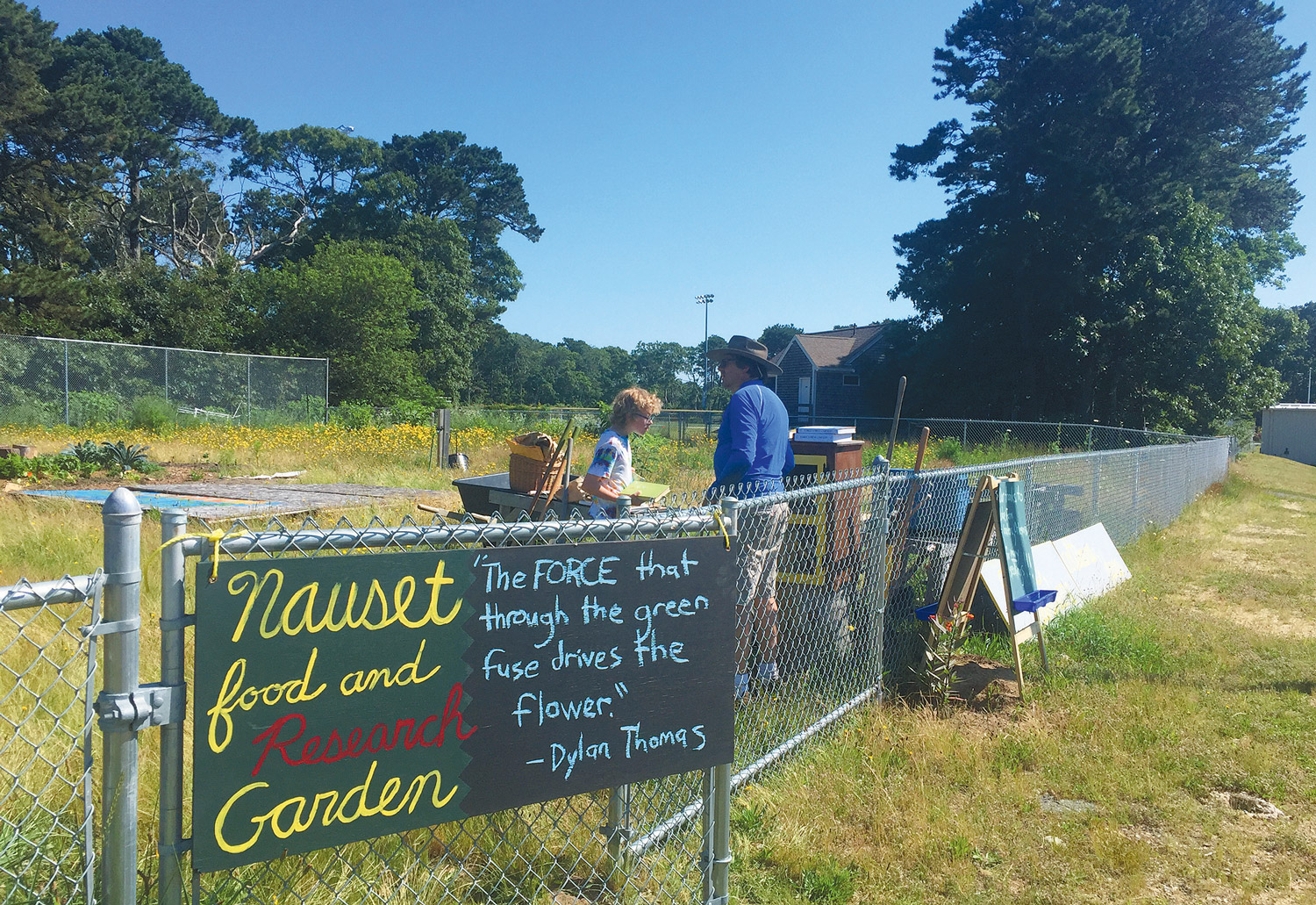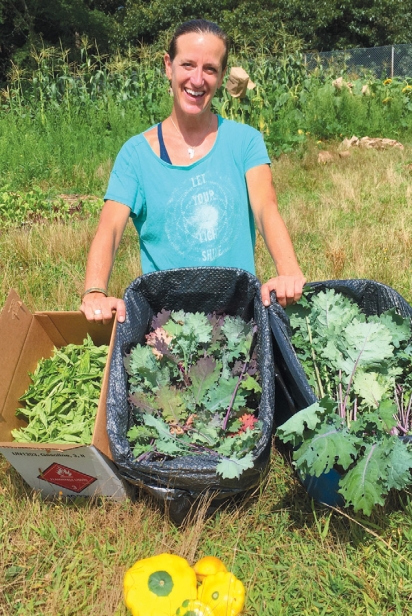Brain Food
Rebooting Nauset High’s Garden
“Rabbits are decimating the beans.”
“Everyone’s perspective on weeds is different.”
“I tried raising cockroaches once, but they escaped.”
It’s a cacophony of voices as individuals and scattered groups tend to various projects, their comments floating above this 100- by 180- foot rectangle of land. Situated in Eastham directly behind the Nauset High School, an overgrown plot where once was sited the School Within a School classrooms, traditional vegetable gardens and a defunct greenhouse, is now getting a reboot.
Two volunteers, Rand Burkert and Gretel Norgeot, are leading the drive to restore this chunk of acreage back to agricultural integrity. Burkert, a former certified organic farmer in Italy and present member of The Food Forest Initiative of Cape Cod, and Norgeot, longtime farmer and Orleans Farmers’ Market director for over two decades, share their passion for the challenge. Speaking at separate times, the two nearly echoed each other’s words at having dreamt of someday working on a garden project like this one.
Dubbed the Nauset High School Food and Research Garden, its two-pronged mission is first, to grow food for the school’s culinary program and local food pantries, and second, to function as a think tank and open-ended lab for scientific, artistic, cultural and an almost endless array of different types of experiences. The pair seeded their concept of a garden with multi-leveled approaches to Nauset’s principal, Dr. Christopher Elsasser. “On board immediately, he’s been nothing but fully supportive,” says Burkert.
In early spring, members of The Food Forest Initiative (a group that aims to promote Cape Cod’s ecological diversity and food security through public plantings and free educational programs), Nauset students, and several local families and home schooled children, performed epic grunt work, clearing the land of debris and rubble from the former structures to make way for its renaissance.
Norgeot next loaned the project her spouse, Jeff, who bulldozed the area to a near-level state and spread the piles of loam that, with Superintendent Tom Conrad’s permission, had been reserved for their use when the football field was re-turfed. Ditto the tennis court rehab; when new fencing arrived, the project requisitioned the old towering chain link material, using it to span the entire rear length of the garden. Norgeot smiles broadly, anticipating its many uses. “Now we can trellis pole beans and cucumbers, and hang student art.”
To achieve soil that would support plant growth and resiliency, last April and May the leaders announced Community Garden Creation Work Days. Nauset faculty and staff, students, and volunteers joined forces to till the ground, establish planting beds and mulch paths. Additional dates involved planting rootstock for future fruit tree grafting, wheelbarrow workouts to compost the veggie beds and, accomplishing one of the Cape’s long-time agricultural traditions, burying rows of seed potatoes.
Long before the groundbreaking, students in Pamela Carpenter’s ESL (English as a Second Language) class experienced growing vegetables as a novel approach to link their new homes in America to their countries of origin. Assisted by Burkert, who is also a Nauset ESL educator, the students tucked seeds native to their homelands into trays of soil in a borrowed corner of a greenhouse (thank you, Nauset Middle School.) As these particular students hailed from Jamaica, Puerto Rico and the Philippines, the veggies chosen were scotch bonnet peppers, ginger, okra, calaloo and garlic. Started amidst winter’s gusting winds, once hardened off, these plants christened the garden, nestled into the first row of soil by the same ESL students.
On May 16th the garden opened its gates to the community with a Seed Planting Day, installing a Wampanoag “Three Sisters” polyculture garden. Corn, squash and beans were planted in close proximity to one another, a traditional way of growing often practiced on land here years ago by the Wampanoags and many other native American nations. This type of agriculture demonstrates the ecological value of growing several species of plants in a single space. Corn seeds were donated by Kitty Hendricks, a member of the Mashpee Wampanoag tribe. Garden members hope to learn much more about growing from the wisdom of the previous generations who lived here.
Sturgis High School teacher Abby Rhoads joined the garden efforts after meeting Burkert. Most interested in encouraging Burkert in developing the lessons and experiential learning that will back the many state teaching standards, Rhoads says, “Working in a garden supports learning in all areas of the curriculum.”
Nauset’s Culinary Arts teacher, Norma Jean Anderson, and her classes had already tasted the success of farm-to-table cooking with produce harvested from the previous garden. A frequent local farm-hopper, she also tours urban food markets with her students, shows foodie films and hosts local chefs. This October 5th, Anderson and her classes will host the fifth annual Farm & Sea-to-Table Dinner, the primary fundraiser of the culinary program. Enrollees in her previous “Soups” courses slurped up hundreds of pounds of produce raised just outside their classroom windows. Attending a past “Future of Food Summit” conference in Milan, Italy, with four of her students, Anderson is eager to pounce on the bounty yet to come.
Quickly the garden has become a sounding board for personal ruminations: the pros and cons of weeds and how to safely eradicate the bad ones; best choices for cover crops; most efficient watering practices; and how to humanely deter pests. Individuals display their skillful knowledge of birds, the songs they sing, insects (both in flight and by their eggs) and native plants. A sweet little portable lending library has mushroomed up, offering botanical guides and gardening theory volumes for the sharing.
Brewster native and current homeschooler Kurt Sparrow, age 14, already having tucked two books into the crook of his arm, is carefully exploring the different areas of the space. Looking forward to reconnecting with a former plant-loving pal from grade four that he just learned will be a Nauset freshman, Sparrow scrupulously identifies every native plant on the fly. He says, “I do enjoy seeing bugs the most, but I study plants more, because they’re easier to raise.”
Off-center in the garden is a circle of tree stumps, room enough for a dozen to pause a while. Herbs are dug into concentric arcs of mulch surrounding the core area, shouldered by strawberries and herbs. A tray of delicate four-inch high asparagus seedlings rests nearby, lacy fern-like tops swaying in the breeze. Cuttings of heirloom rhubarb from local gardeners edge the pathways. Sheets of particle board bleached gray, up-cycled from previous projects, lay together, in claim of a bit of real estate for a future performance stage. Sounds surround us as birds, butterflies and all types of insects alight on bent-over blossoms.
A generous expanse to the left of the seating ring is planted with rows of annual vegetable crops, unusual grains like amaranth, and cover crops like clover. A less spacious area to the right of the gathering spot incorporates permaculture principals. Local arborist Tom Fettig has lead the planting of root stock of several apple and fruit trees. Milkweed plants are flourishing, and nut trees, berries and other edible perennial plants are planned. This zone will be used to explore restorative agriculture theory. Possibly not as productive initially, in time this portion of the space should mirror the patterns and resiliency found in natural ecosystems and be self-perpetuating.
Clara McLardy is one of several members of the Food Forest Initiative investigating the potential for the public one day using land beneath the power lines to grow food. She finds that a lot of agricultural knowledge is practical common sense. Volunteering at the Nauset garden with her children, whom she home-schools, they’ve hauled compost and wood chips. “I read a lot of permaculture books, but by observing you also learn, and it’s not just following a set of rules. A garden is not your typical classroom,” says McLardy. “It’s fun.”
Running nearly the entire length of the garden is a ten-foot-wide median, a designated flower bed for pollinators. Sown with a wildflower seed mix recommended by the Association to Preserve Cape Cod, a variety of blossoms is already attracting gorgeous and very industrious insects.
Principal Elsasser is rallying behind the project, and delights in every facet of learning that it proposes as it unfolds. Future developments may include irrigation and perhaps the creation of a vernal pool. Excited to introduce the garden to the school, he sees it as a resource available to every individual of the faculty. He challenges his entire staff to get out there and try to accomplish whatever it is they may propose to him.
Recalling a recent conversation with Elsasser, Burkert says, “He underlined that his faculty was free to do what they wanted to do, and he meant it. Elsasser believes that the potential of this garden is that it can meet many interdisciplinary needs, and the more the entire community is part of it, and the more diverse in age, culture and interests its participants are, the more alive it will be.”
Impressed by the breadth of community involvement and intergenerational support the garden has already inspired, Elsasser has backed every idea already on the table, and welcomes those to come. Plans are in the works to design composting stations where not only the school’s leaves and grass clippings can be recycled, but the public can donate theirs as well using drop-off areas accessed from existing parking zones. Local companies and businesses including Agway, Lake Farm Gardens and Robert B. Our are also on board, having contributed plants, building supplies and services.
The involvement of Cape farmers and producers of other non-traditional agricultural products such as mushrooms raised on inoculated logs could be a dynamic source of education for students to learn techniques to increase soil fertility, sequester atmospheric carbon and keep crops viable when experiencing periods of drought. Nauset alums, parents and local contacts may be rich sources of experiential learning for topics such as vermiculture (worm composting), raising bees and fabricating biochar (soil amendment).
Curricula could involve the design, fabrication and implementation of the structures needed, including composting bins, a produce washing station, chicken coops, worms bins and portable hoop houses. Consider a local farmer explaining the finances behind his business, breaking down a profit and loss statement, or demonstrating effective grant writing. Imagine sustainable architecture and engineering classes working with a local technical school’s plumbing and heating students to develop and construct a geothermal-heated greenhouse.
Inspiring too are the often unseen, limitless and immeasurable benefits of humans interacting with nature, both alone and as part of group experiences—exercise, time to reflect and the chance to flex all of one’s senses. Not to mention the acquisition of life skills and qualities like goal setting, collaboration, empathy, friendship and the knowledge that you really can grow a great big clump of basil.
“Elsasser sees the garden as a galvanizing idea. He gets it,” says Burkert, recalling the principal’s thoughts. “Life and learning is happening here now.”








